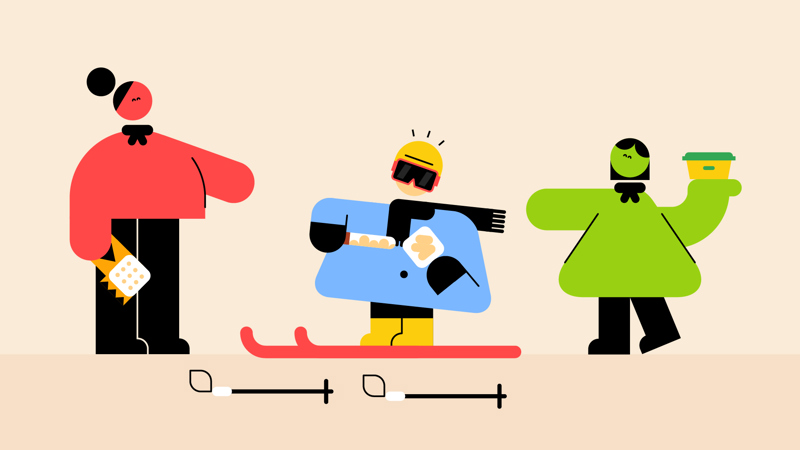
Dress to impress
You’ll need
- Snowsports clothing
- Items for carrying out simple tasks (for example, bottles, sweets or butter)
Before you begin
Ask everyone if they own any equipment or clothing of their own which they could bring for the activity. If you can’t find the exact clothing, you can use other things to represent it.
The clothing you’ll need includes: Base layers, warm layers, waterproof layers and coats or overalls. For equipment, try and bring along helmets, goggles, masks, gloves, boots and skis or snowboards.
Prepare to dress
- The person leading the game should show everyone the clothes, and explain the process of getting dressed for skiing. While they’re explaining, a volunteer should show everyone how to dress correctly.
In general, the best way to dress for snow sports is using the three-layer rule. Base layers go first, to regulate body temperature and fit close, trapping a thin layer of warm air against the skin. Mid-layers go next and trap body heat through insulation. Outer layers act like a shell, keeping out elements such as wind, rain, and snow. Combining layers maximises warmth while letting you remove or add layers in the changeable mountain weather.
- The person leading the game should explain that boots keep your feet dry and warm, but they also support your ankles and keep your feet safe from hazards such rocks.
- Finally, the person leading the game should explain that other equipment is also important when skiing or snowboarding. Helmets keep in warmth, but more important they protect your head in case you crash. A specially painted or colourful helmet can also help you be identified once your face is covered. Goggles or a mask shield your eyes from the bright snow, the sun, and debris that comes when you move fast. Some masks also keep faces warm.
Dress to impress
- Put all of the clothing and equipment in the middle of the space.
- Split into small teams. Each team should stand in a different corner of the space.
- One person in each team is the model – they’re going to get dressed to go skiing. The model cannot move from their team’s corner.
- The other team members should take it in turns to run to the centre and collect an item or clothing or equipment. They should bring it back to their corner.
- The model should put the clothing or equipment on correctly. Only the model can dress themselves – no one else can touch the clothes or equipment once they’re in their corner.
- After five minutes, the person leading the game should make a signal to tell everyone to stop. Teams take anything their model isn’t wearing back to the middle, then stand still around their model.
- Teams should take it in turns to explain which items they chose. The person leading the game should check that everything is on correctly – especially things like gloves and helmets.
- Each team should finish dressing their model so they’re ready to hit the slopes.
The model should try to complete some everyday tasks. For example, open and drink from a water bottle, take off their helmet, pick up a small sweet and put it into a pot or butter a cracker.
Reflection
This activity was a chance to try new things. Trying new things also involves learning about what you need to wear and use to stay safe. Had you seen any of the equipment or clothes before? Was any of it everyday clothing, or was it all special? Were the new things comfortable, or did they feel odd?
This activity was also about being a team player. How did your team work together when collecting items? Did you have a plan? Was there a team leader? How did you choose your model? Would you need to work as a team to get dressed out in the snow (for example, by reminding each other about helmets and goggles, making sure everyone has enough layers on)?
Safety
All activities must be safely managed. You must complete a thorough risk assessment and take appropriate steps to reduce risk. Use the safety checklist to help you plan and risk assess your activity. Always get approval for the activity, and have suitable supervision and an InTouch process.
You could award points for each item the model is correctly wearing. These points could be used to give a head start on the tasks, which could be run as a race.
Not everyone has to put on the clothing and equipment – the people who do should volunteer, and they can stop and take it off at any time.
All Scout activities should be inclusive and accessible.
Anyone who has experience with the items could help explain and demonstrate at the start.
